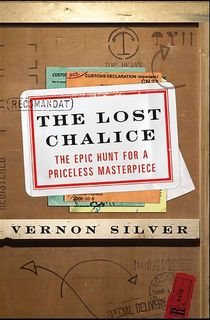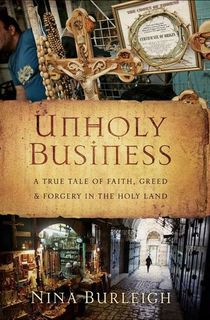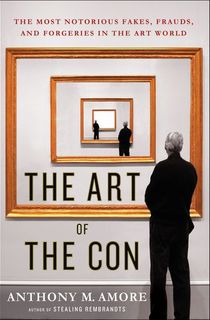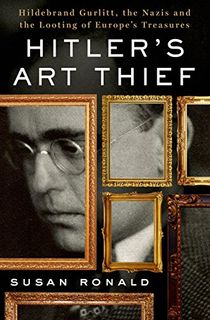Great artwork possesses a unique ability to capture the human imagination, meaning that it has long been coveted by those who truly appreciate the beauty of a specific painting or a particular artist’s style, but equally by the rich and powerful who regard art as a potent status symbol. As with any highly prized commodity, art has also been targeted by criminal organizations, whether through the theft of highly prized individual artworks or the production of highly skilled fakes.
Such was the worldwide interest in the audacious early 20th-century theft of the Mona Lisa that it propelled the painting to superstar status. That mysterious theft is just one of the intriguing mysteries, scams and cons featured in the following eight books on the topic of art crime, all of which illustrate just why this subject still has the ability to capture the imagination today.

The Lost Chalice
In The Lost Chalice, American archaeologist and journalist Vernon Silver traces the riveting history of an exceptionally rare 2,500-year-old wine goblet. Featuring scenes depicting the fall of Troy by Euphronios, one of the most celebrated artists of Ancient Greece, this precious chalice caused quite a stir when, in 1990, it went up for sale in New York and was purchased by a mystery bidder. Silver’s “dizzyingly detailed tale of art and espionage” (Kirkus Reviews) uncovers how the priceless ancient artefact came to be at that New York auction house and reveals the dramatic quest to discover its subsequent whereabouts. Along the way, he exposes the disreputable underbelly of the art world, peopled by grave robbers, smugglers and unscrupulous art dealers.

Unholy Business
With hundreds of archaeological digs taking place at any one time in Israel, new and interesting artefacts from the Biblical era come to the market on a surprisingly frequent basis. However, few, if any, have ever caused the excitement generated by the appearance, in 2002, of an empty first-century limestone box dubbed the James Ossuary. Ossuaries from this era, which were traditionally used for storing the bones of the dead, are unearthed relatively frequently. What set the so-called James Ossuary apart was its Aramaic inscription, which seemed to suggest an association with the family of Jesus himself.
At a subsequent highly publicized forgery trial, the inscription was dismissed by forensic experts as a later addition, leading the Israeli authorities to describe it as “the fraud of the century”. Nina Burleigh’s Unholy Business uses this intriguing story as the basis for an in-depth investigation into the whole industry surrounding the trade of Biblical antiquities. Her absorbing account investigates the unsavory side of the trade in antiquities from the Holy Land, as well as providing fascinating insight into the complex relationship between archaeology, science and religious faith.

The Forger's Spell
Set against the backdrop of Hitler’s rise to power, Edward Dolnick brings vividly to life the true story of one of the 20th-century’s most notorious art forgers in this New York Times bestseller. Over the course of seven years, the little-known Han van Meegeren created a series of paintings copied from the work of the more famous 17th-century Dutch painter, Johannes Vermeer. Van Meegeren’s deception only came to light when he was put on trial as a collaborator after the end of World War II, charged with selling an apparently priceless Vermeer to Nazi leader, Hermann Goering. The Dutchman was compelled to admit that the work was, in fact, a forgery.
Dolnick’s “mesmerizing account” (Kirkus Reviews) of van Meegeren’s criminal activities includes a fascinating exploration into how the Dutch forger was able to fool so many accredited art experts for so long and takes the reader through the practical techniques involved in creating a fake masterpiece, as well as highlighting his considerable expertise in psychological manipulation.

The Art of the Con
For this insightful investigation into the world of art fraud, Anthony M. Amore has assembled a selection of the most ambitious cons and scams to hit the art world over the last century. Unlike headline-grabbing thefts from galleries and museums, these scams have previously attracted relatively little public attention, enabling the author to shine a light on this lesser-known world of con artists, swindlers and fraudsters.
As an expert in art security, Amore is able to provide unique insight into the complexities involved in modern art fraud, as well as the investigatory techniques required to bring the perpetrators to justice. He has made extensive use of interviews and recently released court documents to produce an engrossing account that will appeal to fans of true crime stories and art lovers alike.

The Gardner Heist
The 1990 theft of a dozen of the world’s finest masterpieces from Boston’s Isabella Stewart Gardner Museum remains the largest unsolved art heist in history. More than three decades later, the museum is still offering a $10 million reward for information leading to the recovery of the stolen works.
Following the death of noted art investigator Harold Smith in 2005, reporter Ulrich Boser decided to continue the late detective’s work on the case and to explore some of his unfinished leads. The Gardner Heist reveals the fascinating discoveries made by Boser in the course of his investigation as he travels deep into the art underworld. Boser’s comprehensive account also takes the reader right back to the beginning of the story, exploring how the late Boston heiress Isabella Stewart Gardner first came to assemble the collection. In employing this approach, Boser has produced a well-rounded and illuminating insight into one of the art world’s most notorious unsolved mysteries.

Provenance: How a Con Man and a Forger Rewrote the History of Modern Art
The husband-and-wife team of Laney Salisbury and Aly Sujo collaborated on this book regarding the scam that was once described by Scotland Yard as the biggest art fraud of the 20th century. At the heart of the elaborate scheme were two men, John Myatt and John Drewe. When the pair first met in the mid-1980s, Myatt was eking out a meagre living by selling copies of famous masterpieces. Over the following ten years, he would go on to produce more than 200 paintings in the style of some of the art world’s most famous names. Con man Drewe, who was the mastermind behind the scam, then set about successfully generating false provenance records for Myatt’s work.
Salisbury and Sujo’s engrossing and meticulously researched account looks at the scam from all angles of the story. Particularly interesting are the insights into how Drewe managed to forge such convincing provenances that he was able to fool dozens of art galleries across the world for nearly a decade.

Hitler's Art Thief
The extent to which Hitler’s Nazi regime plundered art treasures from both public and private collections has only really become widely known in recent years. One such revelation came in 2013, when news broke that an astonishing collection of over 1,400 looted artworks had been discovered in the Munich apartment of 80-year-old Cornelius Gurlitt. The man behind the collection was Gurlitt’s art dealer father, Hildebrand, who, during the Nazi era, was one of just a handful of men officially authorized to handle the thousands of artworks looted during World War II.
Susan Ronald’s meticulously researched Hitler’s Art Thief relates Hildebrand Gurlitt’s remarkable story and reveals how he became one of Nazi Germany’s most prolific art looters, even daring to divert some of the best artwork intended for the regime’s leading figures to his own personal collection. Along the way, she skillfully interposes the Gurlitt family’s story with insight into the wider historical context in which he was operating, reminding the reader that behind many of the looted artworks lay the personal tragedy of victims of the oppressive Nazi regime.

Vanished Smile
When Leonardo da Vinci’s famous masterpiece was mysteriously stolen from the Louvre in 1911, its disappearance made headlines across the world. The subsequent two-year hunt for the missing painting involved many twists and turns, even including, at one point, the arrest of Pablo Picasso. The eventual culprit, Vincenzo Peruggia, claimed at his trial to have stolen the Mona Lisa out of a misplaced patriotic desire to see it returned to its native Italy. Over a century later, questions remain as to the real motivation behind the painting’s disappearance.
In Vanished Smile, R.A. Scotti reopens the investigation into this real-life “whodunit” that rocked the art world just over 100 years ago. The author has delved deep into the records to produce this riveting account, shedding some interesting new light on the circumstances surrounding the mysterious theft. She also excels in exploring the wider implications of this audacious crime, not least its part in propelling the Mona Lisa to the superstar status it enjoys today.
This post is sponsored by Open Road Media. Thank you for supporting our partners, who make it possible for The Archive to continue publishing the history stories you love.



